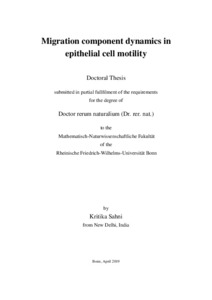Migration component dynamics in epithelial cell motility

Migration component dynamics in epithelial cell motility

| dc.contributor.advisor | Merkel, Rudolf | |
| dc.contributor.author | Sahni, Kritika | |
| dc.date.accessioned | 2020-04-26T22:13:28Z | |
| dc.date.available | 2020-04-26T22:13:28Z | |
| dc.date.issued | 05.08.2019 | |
| dc.identifier.uri | https://hdl.handle.net/20.500.11811/8059 | |
| dc.description.abstract | Cell migration is a fundamental process in development and maintenance of multicellular organisms. Harmonious cellular movement is coordinated by finely tuned assembly and release of cell-substrate attachment sites. Functional asymmetry at cell front and rear enables activation-deactivation of specific molecules that assists in formation of new attachment sites at front and release of old ones at rear. These cell attachment sites are discrete multi-protein complexes and are known as focal adhesions (FAs). Additionally, cytoskeletal microfilament network acts as cellular framework, which assists in forward protrusion of cell’s leading edge and coordinates simultaneous retraction of cell’s rear edge. Composed of actin and myosin, the microfilament network is arranged into thin filaments and thick stress fibers. Components of the microfilament network, work in accord with each other and with focal adhesion complex proteins, to facilitate the formation of discrete cell front and rear, thereby determining directional cellular movement. Efficient cell movement requires rapid rearrangement (assembly-disassembly cycles) of microfilament and focal adhesion network. In this work, dynamic behavior of cytoskeletal and focal adhesion components was monitored, using migrating primary human epidermal keratinocytes (nHEKs) as model systems. In order to characterize transport of molecules as well as their exchange behavior in distinct sub-cellular structures during migration, green-to-red photoconversion property of dendra2 fluorophore was utilized. In combination with live cell imaging, localized light induced conversion of dendra2 tagged proteins enabled tracking down their redistribution and structural turnover. Using dendra2 fusion constructs of actin and myosin, dynamic properties of both proteins in different types of stress fiber structures were identified. Follow- ing actin distribution by cytosolic transfer, transverse arcs located in the cell body, demonstrated very low exchange for actin. However, higher actin turnover was observed in ventral stress fibers, located at cell rear. Unlike actin, myosin displayed no measurable cytosolic transfer. Instead, myosin propagation occurred exclusively along the existing actin stress fiber network. Myosin propagation speed along the rear ventral stress fiber, was further observed to correlate directly with overall speed of cell’s movement. Additionally, turnover dynamics of a focal adhesion resident protein, vinculin, in different focal adhesion types was monitored in this work. The analyzed adhesion types were nascent adhesions (at front), mature adhesions (in cell body) and disassembling adhesions (at rear). Using in-house image processing tools, faster vinculin turnover of frontal nascent adhesions was identified, compared to slower turnover of mature adhesions in the cell body. Interestingly, the slow turnover mature rear-end focal adhesions were observed to switch their exchange kinetics to faster turnover state, shortly before disassembly close to the rear cell edge. Upon closer examination, the rear end disassembling adhesion complexes indicated differential turnover at two opposite ends. The distal FA end, facing the outer cell periphery, displayed higher turnover than the cell body facing proximal FA end. | en |
| dc.language.iso | eng | |
| dc.rights | In Copyright | |
| dc.rights.uri | http://rightsstatements.org/vocab/InC/1.0/ | |
| dc.subject | Cell migration | |
| dc.subject | Stress fibers | |
| dc.subject | Focal adhesions | |
| dc.subject | Protein dynamics | |
| dc.subject | Cell polarity | |
| dc.subject.ddc | 540 Chemie | |
| dc.title | Migration component dynamics in epithelial cell motility | |
| dc.type | Dissertation oder Habilitation | |
| dc.publisher.name | Universitäts- und Landesbibliothek Bonn | |
| dc.publisher.location | Bonn | |
| dc.rights.accessRights | openAccess | |
| dc.identifier.urn | https://nbn-resolving.org/urn:nbn:de:hbz:5n-55416 | |
| ulbbn.pubtype | Erstveröffentlichung | |
| ulbbnediss.affiliation.name | Rheinische Friedrich-Wilhelms-Universität Bonn | |
| ulbbnediss.affiliation.location | Bonn | |
| ulbbnediss.thesis.level | Dissertation | |
| ulbbnediss.dissID | 5541 | |
| ulbbnediss.date.accepted | 10.07.2019 | |
| ulbbnediss.institute | Mathematisch-Naturwissenschaftliche Fakultät : Fachgruppe Chemie / Institut für Physikalische und Theoretische Chemie | |
| ulbbnediss.fakultaet | Mathematisch-Naturwissenschaftliche Fakultät | |
| dc.contributor.coReferee | Kubitscheck, Ulrich |
Dateien zu dieser Ressource
Das Dokument erscheint in:
-
E-Dissertationen (4337)




